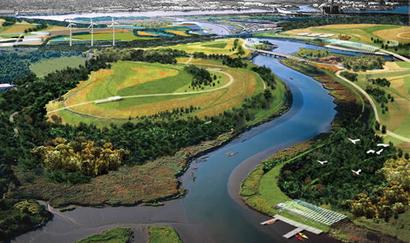'The Queens Museum atrium is devoted to the artist’s work on Fresh Kills, a massive Staten Island landfill that’s currently undergoing a 30-year process of being transformed into a park, as well as two other, smaller landfills. [...] “How does a place switch its meaning and become something else?” she writes in a 2001 proposal. To her, Fresh Kills is “a true social sculpture composed of 150 million tons from literally billions of individual decisions and acts of rejection.” Early on she envisioned a series of projects in which members of the public would donate objects they considered valuable for embedding in soil at the site. That proposal gave way to another one, since approved, that she’s been working on since 2008: “Landing,” an overlook positioned between two earthworks in Fresh Kills’ South Park. The model and structural drawings for the project are a bit cryptic, but what’s crucial is the sense of transformation they convey. As it turns out, maintaining and caring for the earth offer all sorts of possibilities for developing the world anew.'
Image of the future Freshkills Park
Source: Wikimedia Commons
In her essay 'Trash: Public Art by the Garbage Girls' (2000), Jo Anna Isaak noted that 'landfills seem to be the oeuvre of choice for a number of women artists.' She discussed the work of Ukeles alongside Agnes Denes' Tree Mountain (considered in two of my earlier posts here and here) and Nancy Holt's New Jersey Landfill Project. You can read about Holt's original proposal at the New York Times site, in an article from 1986 (her Sky Mound remains only partially completed). Isaak quoted Holt's view that landfills would come to be seen as a distinctly late twentieth century version of a distinctive human structure that has a long and varied history, the rubbish dump. Other more recent examples of women transforming landfill sites and garbage dumps include Jean Shin's sculptural installation at Seattle's North Transfer Station and Martha McDonald's song tour of a construction-waste recycling facility in Northeast Philadelphia.
In North America at least, it seems as if any self-respecting landfill site now has an artist-in-residence. There's probably still time to apply for the scheme that was advertised last month for an artist to work at the waste management centre in Edmonton. The best place to be a landfill artist may well be San Francisco, where 150 artists have now been through the Artist in Residence programme at Recology, the San Francisco Transfer Station and Recycling Center. Clearly the aim of many of these artists is to recycle and transform the rubbish collected in these sites, as much as it is to comment on excessive consumption and environmental degradation. Musicians too can adapt a landfill site to new ends, working with the materials on hand - Paraguay's Recycled Orchestra have received quite a lot of global attention and were the subject of a documentary, Landfill Harmonic (see clip below). Writers have only their own words, but they can still change attitudes. It remains to be seen whether John Wedgwood Clarke represents the beginning of a new trend for landfill poets.

No comments:
Post a Comment